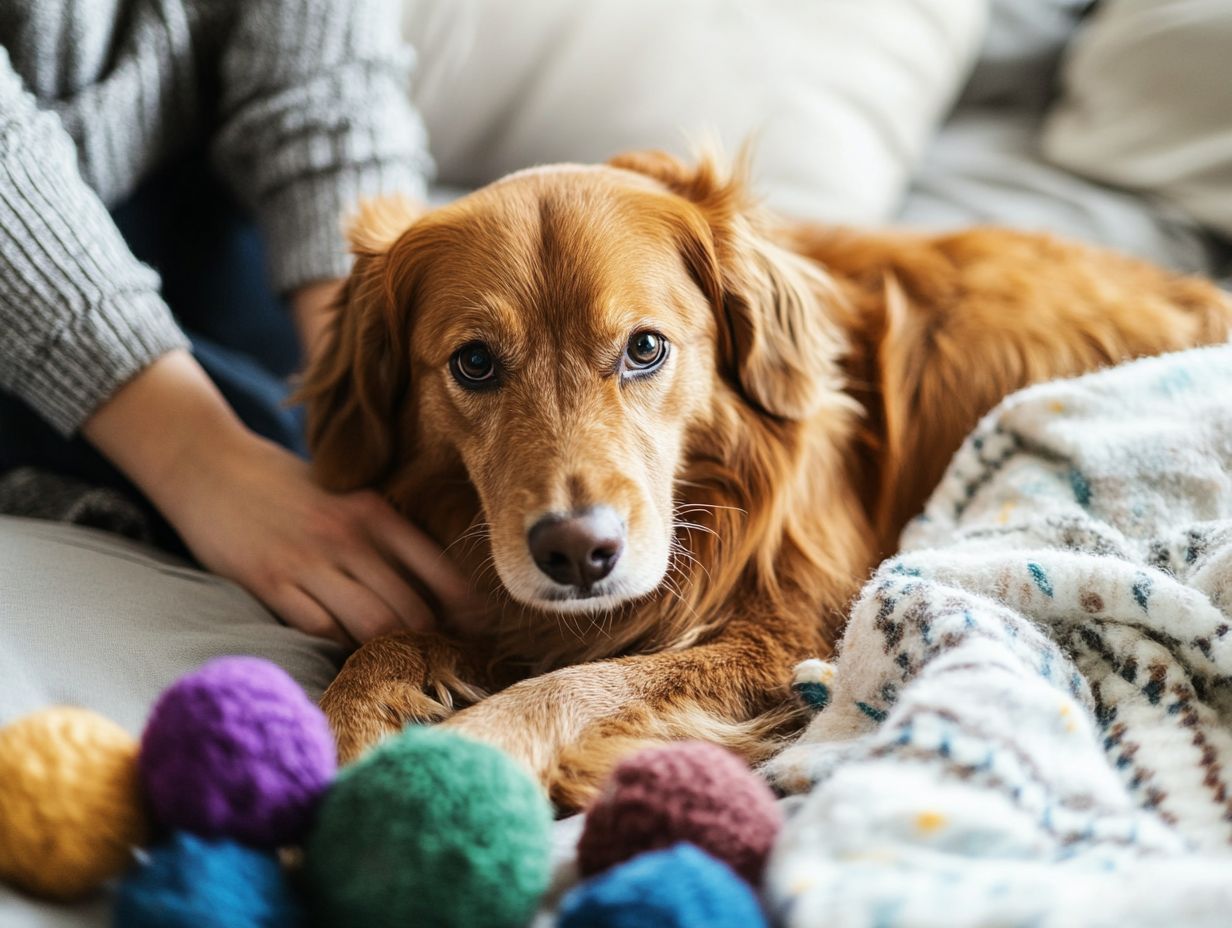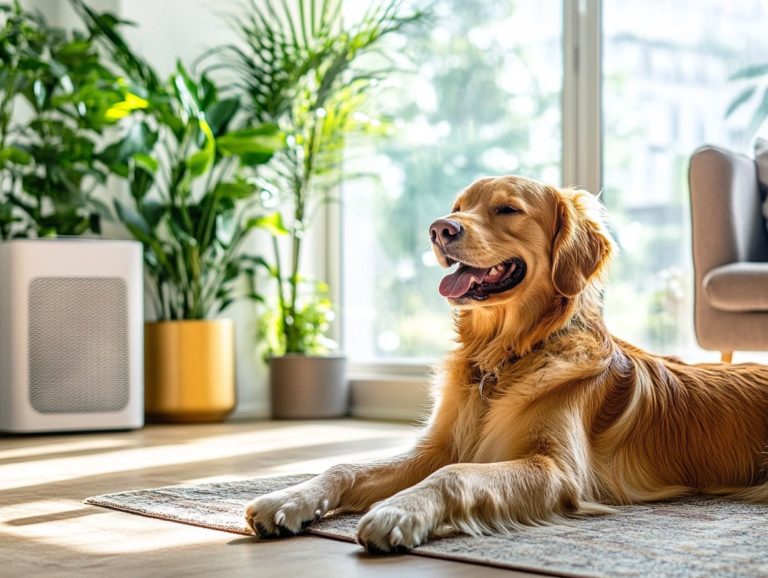How to Create a Routine for Anxious Pets
Anxiety in pets presents a challenging dilemma for both the animals and their devoted owners. Understanding what causes anxiety in pets helps you support them effectively.
This guide will walk you through creating a safe and calming environment for your pet. You ll learn to craft a comfortable space and manage distractions effectively. Discover how establishing a daily routine, incorporating regular exercise, and seeking professional help can significantly benefit anxious pets.
Dive into practical strategies designed to foster relaxation and enhance the well-being of your beloved companions.
Contents
- Key Takeaways:
- Understanding Anxiety in Pets
- Creating a Safe and Calming Environment
- Establishing a Daily Routine
- Incorporating Exercise and Mental Stimulation
- Seeking Professional Help
- Frequently Asked Questions
- What is the importance of creating a routine for anxious pets?
- When should I start implementing a routine for my anxious pet?
- What are some key elements to include in a routine for anxious pets?
- How can I introduce a new routine to my anxious pet?
- What should I do if my pet becomes anxious during their routine?
- Is it important to stick to the routine even on weekends or holidays?
Key Takeaways:

Understanding Anxiety in Pets
Understanding anxiety in pets is key for you as a pet parent. It helps ensure your dog s mental health and overall well-being.
Several factors contribute to anxiety in dogs, such as changes in their environment, limited socialization opportunities, and an insufficient daily routine.
By recognizing these elements, you can implement effective strategies to alleviate your dog s anxiety. This fosters a calming atmosphere that encourages healthy behaviors.
Causes and Triggers
The causes and triggers of anxiety in pets can vary greatly, often shaped by their unique experiences and backgrounds. Past trauma, lack of training, and loud noises can seriously affect a dog’s mental health.
Environmental changes, such as relocating to a new home or introducing unfamiliar animals, can intensify feelings of anxiety. A lack of socialization can lead to fearfulness in certain situations, making it essential for you to recognize these triggers in your dog.
By gaining insight into what fuels your pet’s anxiety, you can take proactive steps to address behavioral issues more effectively. Techniques like gradual desensitization, counterconditioning, and understanding the needs of anxious pets can help alleviate these triggers.
These methods nurture a more secure and confident pet over time.
Creating a Safe and Calming Environment
Creating a safe and calming environment for your dog is crucial in managing pet anxiety and enhancing their overall well-being. This means thoughtfully designing a comfortable space where they can retreat when feeling overwhelmed.
Establishing a structured daily routine, with a consistent feeding schedule and regular exercise, greatly benefits their emotional health.
Designing a Comfortable Space
Designing a comfortable space for your dog can profoundly enhance their sense of security and well-being. This sanctuary should be adorned with their favorite toys, a plush bed, and items that evoke memories of joyful companionship.
In this welcoming environment, quality bedding offers the essential support they need for restful slumber. Interactive toys, which can be filled with treats, stimulate their minds and encourage healthy play.
Incorporating these elements not only alleviates anxiety but also nurtures emotional health. This ensures your furry friend feels safe and engaged when lounging in their special spot.
A thoughtfully designed haven can significantly strengthen the bond between you and your dog, creating a space where happiness and comfort truly go paw in paw.
Managing Noise and Distractions

Managing noise and distractions is essential for reducing pet anxiety. Helping your dog feel more secure in their environment can be achieved through simple measures. Using white noise machines or soundproofing specific areas in your home can establish a calming routine. This significantly benefits your dog’s overall mental health.
Incorporating calming music specifically designed for pets can further elevate their sense of tranquility. Many dog parents discover that high-potency essential oils, such as lavender or chamomile, create a soothing atmosphere. These can help alleviate anxiety during stressful situations like thunderstorms or fireworks.
Watch closely! Your dog’s reactions will tell you what works best when you introduce these calming strategies. Some dogs may respond positively to certain sounds or scents, while others may not. Regularly assessing their comfort level and adapting the environment is key. If a favorite spot becomes too noisy, consider relocating their bed or crate to a quieter area. This creates a sanctuary where they can unwind in peace.
Establishing a Daily Routine
Establishing a daily routine can profoundly enhance your dog’s well-being and help alleviate pet anxiety. By creating a structured day that includes consistent feeding schedules, regular exercise, and designated socialization opportunities, you provide your dog with a sense of security and comfort. For more tips, check out this guide on how to help an anxious pet adjust to new environments.
Knowing what to expect each day helps your furry companion feel more at ease and in control of their environment.
Benefits of a Routine for Anxious Pets
Using a daily dog routine offers many benefits for anxious pets. It creates a sense of stability and predictability in their lives. This structured approach not only helps alleviate your pet’s anxiety but also addresses behavior issues. To further support your furry friend, learn how to create a safe space for anxious pets, fostering positive habits and reinforcing training.
Whether you have a curious puppy exploring their new world or a senior dog savoring their golden years, routines can be customized to suit their specific needs. Regular feeding times, exercise, and grooming sessions enhance their mental well-being and contribute to better physical health.
By establishing consistent patterns, you can significantly improve your pet’s behavior management. This leads to fewer accidents and a calmer demeanor. For puppies, this means fostering good habits that set the foundation for a lifetime of positive behavior. Meanwhile, senior dogs thrive on comfort and predictability. This reduces stress and accommodates their evolving needs.
Tips for Creating a Routine
- Begin by establishing a feeding schedule.
- Incorporate exercise routines.
- Carve out time for training classes or socialization opportunities to enhance your dog’s overall well-being.
- Set aside specific times each day for walks and play, tailored to your dog’s energy levels and breed characteristics.
- Include mental stimulation activities, like puzzle toys or obedience training sessions, to keep their minds engaged.
- Schedule quiet time for your dog to unwind, promoting relaxation and balance in their routine.
By thoughtfully integrating these varied elements, you not only support your dog’s physical health but also nurture their emotional happiness and training success.
Incorporating Exercise and Mental Stimulation
Incorporating exercise and mental stimulation into your dog s daily routine is vital for ensuring both their physical health and well-being. Regular exercise significantly reduces anxiety and offers a productive outlet for their energy.
Engaging them with interactive toys and training activities nurtures positive behaviors. This enriches their lives in profound ways.
Start building a routine today and watch your pet thrive!
Activities to Reduce Anxiety and Promote Relaxation

Engaging in specific activities can greatly reduce anxiety and promote relaxation in your dog, enhancing their overall well-being. Consider these activities:
- Hiring a dog walker
- Using lickimats a mat you spread food on to keep your dog busy during mealtime
- Enrolling in training classes
These not only provide essential physical exercise but also strengthen the bond and trust between you and your furry friend.
Interactive playtimes, like fetch or tug-of-war, boost joy levels and deepen your connection, creating a sense of security and attachment. Structured walks allow your dog to explore their surroundings, stimulating their minds and alleviating stress through balanced physical exertion.
Incorporating puzzle toys or canine agility courses offers cognitive engagement, ensuring that playtime is not just fun but also mentally enriching. Together, these activities foster positive behavioral patterns and help mitigate anxiety, making your dog feel valued and loved.
Seeking Professional Help
If you’re feeling overwhelmed, don’t hesitate to ask for help from a veterinarian or an animal behaviorist. These experts can offer valuable insights that enable you to create a customized strategy tailored to your dog’s specific needs.
Whether through training classes, behavioral therapy, or medical interventions, their guidance can significantly enhance your approach and improve your pet s well-being.
When to Consult a Veterinarian or Animal Behaviorist
Knowing when to consult a veterinarian or an animal behaviorist is essential for effectively tackling anxiety in your pets. If you notice persistent behavior issues, excessive barking, or destructive tendencies, it s a clear signal that professional intervention may be needed.
These warning signs, especially when paired with a lack of progress from home-based strategies like positive reinforcement and environmental adjustments, indicate that a more specialized approach is warranted. You might observe your furry companion becoming increasingly withdrawn or showing signs of stress during routine activities.
Recognizing these changes is crucial, as timely intervention can ease anxiety and significantly enhance your pet’s overall quality of life.
With expert guidance in anxiety treatment, you can employ tailored techniques that effectively address the root causes of these issues and support your dog’s mental well-being.
Frequently Asked Questions
What is the importance of creating a routine for anxious pets?
Establishing a routine can help reduce anxiety in pets by providing a sense of predictability and stability in their daily lives, as outlined in the role of routine in training anxious pets.
When should I start implementing a routine for my anxious pet?

It is best to start creating a routine for your anxious pet as soon as possible, as this can help prevent their anxiety from worsening. For more insights, check out understanding the role of routine in pet anxiety management.
What are some key elements to include in a routine for anxious pets?
A routine for anxious pets should include regular feeding times, exercise, playtime, and calm moments for relaxation. Additionally, the importance of routine for anxious pets cannot be overstated; it should also be consistent and tailored to your pet’s individual needs.
How can I introduce a new routine to my anxious pet?
When introducing a new routine, make gradual changes to prevent overwhelming your pet. Starting with small adjustments can help ease the process, and you can refer to tips for training anxious pets at home for effective strategies to create a positive environment as you gradually increase the structure over time.
What should I do if my pet becomes anxious during their routine?
If your pet shows signs of anxiety during their routine, try to remain calm and reassure them. You can also incorporate calming techniques, such as gentle music or massage, along with crate training for anxious pets, to help them relax.
Is it important to stick to the routine even on weekends or holidays?
Yes, it is important to maintain the routine for your anxious pet even on weekends or holidays. This will provide them with a sense of consistency and stability, which can help reduce their anxiety levels. For more tips, check out this guide on how to foster a positive environment for anxious pets.






